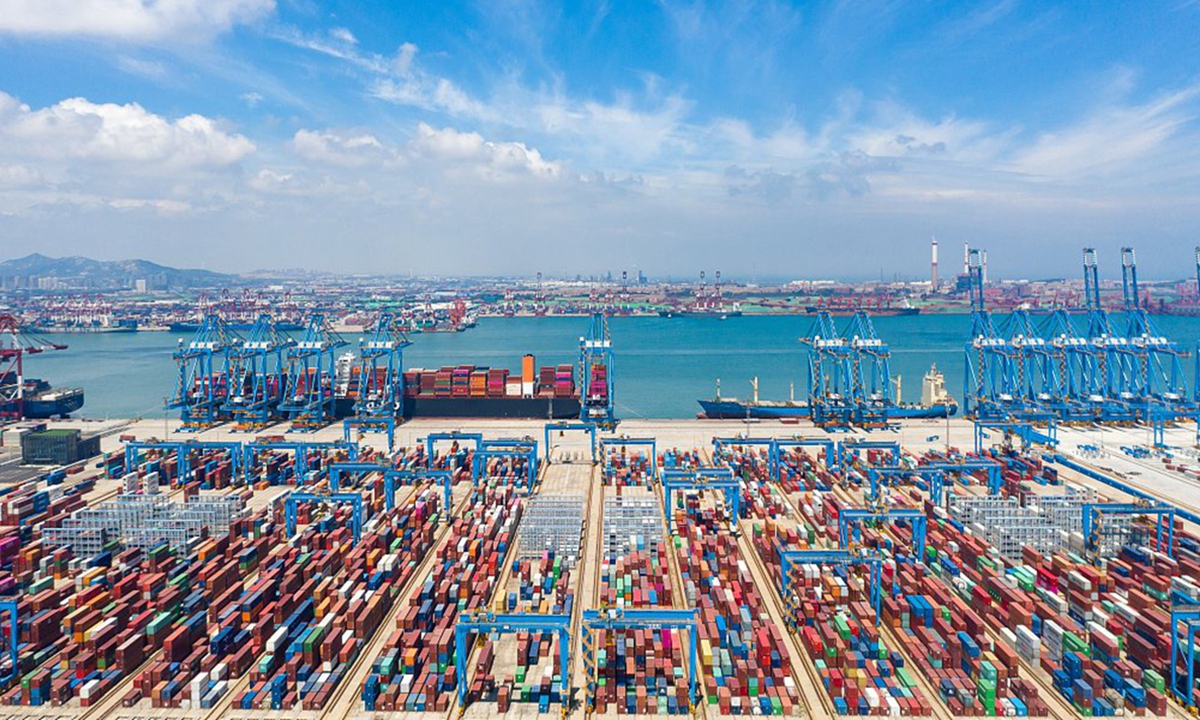

China trade economy File photo: VCG
Since the outbreak of the COVID-19 pandemic, the pressure on the real estate market and fluctuations in the stock market have caused asset-side shocks, resulting in adjustments to the balance sheets of various sectors of China's real economy. This has, to some extent, restrained the expansion of total demand and hindered the economic recovery.
A heated debate has arisen regarding whether China's economy has entered a "balance sheet recession." Some observers go as far as to suggest that China's economic situation is similar to Japan's situation in the 1990s, hinting that China could potentially replicate the errors of a "Japanese-style balance sheet recession" and face prolonged stagnation.
The concept of "balance sheet recession" was proposed by economist Richard Koo when studying the economic downturn triggered by the bursting of the asset bubble in Japan in the 1990s. Although the concept is not entirely rigorous from an academic perspective, it points out three distinct features in Japan's economy at the time: asset shrinkage, debt contraction, and economic recession.
Given that the balance sheets of various sectors in China have not experienced a significant contraction - negative growth in debt, and considering that asset shrinkage remains within normal range, coupled with the resilience of the economy and achieving recovery growth, it is believed that China has not experienced a "balance sheet recession."
The current economic situation in China shows significant differences from Japan's economic recession.
During the post-pandemic economic recovery, the overall decrease of asset prices in China has been relatively contained. In terms of housing price changes, residential sales prices in 70 large and medium-sized cities entered a negative growth range starting from the second quarter of 2022, with a cumulative decrease of 8.3 percent by the end of 2023. Take a look at the stock price changes. Since 2022, the Shanghai Composite Index has fallen from a high of over 3,600 points, dropping below 2,700 points at one point, but has since risen back above 3,000 points.
The decline in asset prices in China is still within normal range, far from a situation of asset prices "collapsing." In comparison, Japan's situation has been much severer. Since the 1990s, Japan's rapid tightening of monetary and real estate policies led to the bursting of the asset bubble, causing significant adjustments in both the stock and real estate markets.
From the perspective of liabilities, the debt of each sector in China's economy is still growing, far from falling to a contraction.
One of the important characteristics of "balance sheet recession" is that the private sector shifts from maximizing profits to minimizing debt, leading to a contraction of debt. After the burst of the Japanese bubble economy in 1990s, the private sector's balance sheet shrank significantly. From 1998, debt continued to shrink for a long period of 15 years, until it turned into positive growth in 2013.
In stark contrast, the expansion speed of debt for Chinese residents and corporate sectors has slowed, but there has never been a contraction of debt. By the end of 2023, the debt of the Chinese household and corporate sectors increased by 6.9 percent and 9.1 percent year-on-year, only half of the average growth rate of the past 20 years, but still far from a recession.
From the perspective of economic growth, China's economy has maintained strong resilience and achieved recovery growth.
"Balance sheet recession" does not only refer to the contraction of the balance sheet itself, but more importantly, this contraction may lead to economic recession. For example, influenced by the balance sheet recession, Japan has been stuck in a 30-year economic stagnation. Since 1990, with the bursting of the asset bubble leading to a balance sheet recession, Japan's economic growth rate has long been around 1 percent, resulting in a continuous decline in Japan's global economic share from its peak of 17.9 percent in 1994 to 3.5 percent in 2023.
In contrast, China's economic growth rate is significantly above those of the world's major developed economies, providing important support for global economic recovery. In 2023, China's GDP exceeded 126 trillion yuan ($17.50 trillion), with a year-on-year growth of 5.2 percent, an increase of 2.2 percentage points compared to 2022, further consolidating the trend of recovery and improvement. China has contributed over 30 percent to global economic growth for several consecutive years, making it the largest engine of global economic growth.
The analysis above indicates that the so-called balance sheet recession characterized by asset shrinkage, debt contraction, and economic decline has not occurred in China. While asset prices have decreased leading to asset shrinkage, the crucial mechanism of debt contraction triggering economic recession has not taken place - in fact, debt across various sectors in China is still expanding, and the economy continues to grow at a relatively fast pace.
Furthermore, in China, the balance sheets of the three major sectors have not only avoided decline but have shown new vitality. The balance sheets of residents, enterprises, and governments, supported by consumption, private investment, and local economic vitality, have begun to expand.
The asset-liability balance sheet of Chinese residents has begun to improve, primarily evidenced by the decrease in deposit accumulation and a gradual transition from savings to consumption. In the fourth quarter of 2023, the growth of residents' deposits in China was 2.4 trillion yuan less compared with the same period last year, indicating a weakening of precautionary savings demand. In 2023, China's total retail sales of consumer goods exceeded 47 trillion yuan, a year-on-year increase of 7.2 percent. The rising of development-oriented consumption has become a highlight of the consumption recovery.
There has been an increase in the vitality of private investment. A major highlight of the repair of corporate balance sheets in China is the enhanced vitality of private investment. In 2023, private fixed-asset investment in China decreased by 0.4 percent year-on-year, but excluding real estate development investment, it increased by 9.2 percent year-on-year, showing resilience in private investment growth.
Third, the central government vigorously supports debt restructuring, and local economic vitality has been enhanced. Considering that local governments are generally burdened by debt, exhausted in dealing with debt repayment pressures, the central government has provided substantial support to help local governments repair their balance sheets, easing the burden on them and greatly stimulating the enthusiasm of local governments to develop the economy.
To consolidate and enhance the positive momentum of China's economic recovery, macroeconomic policies should continue with an expansionary tone and strengthen the coordination of fiscal and monetary policies.
On one hand, the central government should expand its balance sheet, particularly by increasing debt issuance. On the other hand, maintaining a significant interest rate reduction will reduce interest payments on existing debts and provide support for asset prices. More policies that are conducive to stabilizing expectations and boosting confidence should be introduced to help strengthen the balance sheets of microeconomic entities and ensure the steady progress of the economy.
The author is professor of economics and the director of National Institution for Finance & Development, Chinese Academy of Social Sciences (CASS), director and research fellow of the Institute of Finance Research at the CASS. bizopinion@globaltimes.com.cn

